Tribals, Dikus and the Vision of a Golden Age Class 8 History Chapter 4 – Explanation, Question and Answers
CBSE Class 8 History Lesson Tribals, Dikus and the Vision of a Golden Age – Detailed explanation of the chapter ‘Tribals, Dikus and the Vision of a Golden Age‘ along with question answers. Given here is the complete explanation of the lesson, along with all the exercises, Question and Answers given at the back of the lesson.
Class 8 History – Chapter 4
Tribals, Dikus and the Vision of a Golden Age
Today we all lead a very comfortable life in the cities with all the facilities available to us but do you know there are some people who still live in forests, known as tribal people. Well in this chapter we will study about some of the tribes of our country and their struggle against the ‘dikus’ which means those who were outsiders for these tribals.
Tribals, Dikus and the Vision of a Golden Age Class 8 Video Explanation
Birsa Munda
In 1895, a man named Birsa who belonged to Munda tribe started gaining popularity. Many people believed that he had magical powers with which he could cure diseases and multiply grains. He himself declared that god had appointed him to help people and safeguard their interests from dikus. Birsa was born in Munda tribe which is found in Chottanagpur region of Jharkhand but was also famous among other tribes such as santhals and oraons.
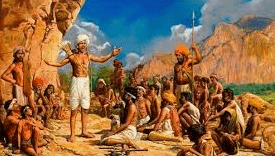
Why birsa declared that he would help tribals and safeguard them from dikus. Who were these dikus?
Well here the dikus is referred to the Britishers.
Why did they want to safeguard themselves from the Britishers?
It is because these tribes had their own way of living. Their society, beliefs were different from those who lived in cities or villages. They felt that they were being enslaved by the dikus. To know more about them we have to read this chapter further.
The tribal societies had different rituals which were not similar to that of the Brahmins. They didn’t have any social divisions on the basis of caste. People belonging to same tribe often thought of sharing the same kinship. However, these tribes had some social and economic differences. So, let’s see how the tribal groups live?
How the tribal group lived?
The tribes had different ways of living and their activities also differed from each other. How? Let’s see.
Jhum cultivators
They practiced shifting cultivation. This was done on small patches of land within the forest by clearing them. Under this system trees were cut from the top in order to bring sunlight to the ground. Land was cleared by burning the vegetation. The ash was scattered on the ground to increase the fertility of land and then seeds were scattered. After harvest, the land was left fallow in order to allow it to gain fertility and cultivation was done on another piece of land. These types of cultivators were found in hilly areas and the northeastern forests and central India.
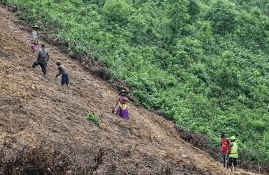
Hunters and gatherers
In many tribes people survived by hunting and gathering forest produce. The Khonds of Orissa follow this practice. They depended on the forest produce such as fruits, roots, meat from hunting and oil from flowers such as mahua. For medicines, they relied upon forest shrubs and herbs and sold forest produce in the local markets. The weavers and leather workers used to buy palash and kusum flowers from khonds to dye their clothes and leather. Sometimes they exchanged their goods for the things they were in need of just like ‘barter system’. In some cases they had to do some labour work also to earn their living.
Tribes like ‘Baigas’ from central India never worked for anyone. It was below the dignity of baigas to do labour work as they were the forest men who had to depend only on forest produce for their survival.
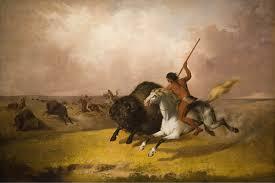 Animal herding
Animal herding
Some of the tribes used to herd animals and rear cattle. They were pastoralists who moved with their cattle and sheep from one place to another after the grass of the particular land had exhausted. The Van Gujjars of Punjab and Labadis of Andhra Pradesh were cattler herders. The Gaddis of Kullu were shepherds and Bakarwals of Kashmir as the name suggests, reared goats.
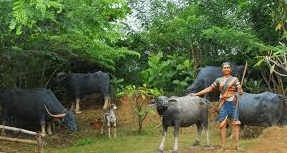
Not all were living a nomadic life. Some of them settle down at some particular place let’s read about them.
Some took to settled cultivation
Many of the tribal groups began settling down and started cultivation with plough. This means now they did not indulge in shifting cultivation. Finally, they got the right over the land that they were cultivating. In the case of Munda tribe, the land was owned by the whole clan and there were only some instances where someone acquired more power than others. He was referred to as chief who had special rights that he could even rent out his land instead of cultivating himself.
According to Britishers, Santhals and Gonds were more civilized than the hunters and shifting cultivators. Those living in forests were considered wild and cruel.
So now we know that the tribals had different ways of living but what made them against the dikus (Britishers)? Let’s see this.
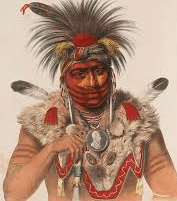 How did colonial rule affect tribal lives?
How did colonial rule affect tribal lives?
The lives of tribal people changed a lot during British rule. How? Let’s have a look at this.
What happened to the tribal chiefs?
Before the arrival of the British in many areas, the tribal chiefs had their own importance. They had some economic powers and control over the territories under them. At some places they had their own policy. During the British rule they lost some of their powers. They were allowed to keep control over village and rent out the lands but they lost their administrative powers and were forced to follow British rules. They were forced to discipline tribal groups as per the Britishers and had to pay tributes to the Britishers. They lost their authority over their men and were not able to execute some of their traditional functions.
After this, came the problem with shifting cultivation.
What happened to the shifting cultivators?
The British were of the view that shifting cultivators should settle down at a fixed place.
They wanted them to work like peasant cultivators as it was easy to control and administer the settled peasants. The British wanted regular inflow of income so they measured the land and fixed the revenue. The rights over the land were defined. Some of the people were declared owners and other the tenants. We have read this earlier.
The British effort to settle jhum cultivators was not very successful for the following reasons:
- Plough cultivation was not successful in dry areas where water was scanty.
- Some of them faced difficulty with plough cultivation as their fields did not give good yield.
Therefore, jhum cultivators of north east insisted on shifting cultivation. The Britishers, after facing revolt from these jhum cultivators, had to allow them to continue with the practice on some patches of forest land.
What else was affecting their life? Let’s check this out.
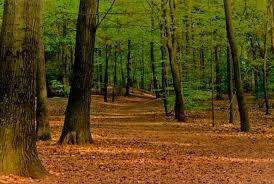 Forest laws and their impact
Forest laws and their impact
The British gained control over all the forests and declared them as state property. They also formed some rules and regulations. Some forests were declared as reserve forests as the timber was needed by the Britishers. No one was allowed to move freely in such forests. Fruit collection, animal hunting and jhum cultivation was banned. This made the life of tribals miserable. So, they had to move to other places in search of work.
But was that beneficial for Britishers? Well, they also faced the problem of non availability of labourers for their own work in these forests such as cutting of trees, transporting logs, etc.
So, they came up with the idea of providing jhum cultivators with small patches of land in the forests with the condition of providing labourers during their hour of need. So, in many regions forest department established forest villages for regular supply of cheap labour. But some of the tribes were not happy with these restrictions and so they started disobeying rules which sometimes resulted into revolts. Songram Sangma revolt of Assam in 1906 is one such example.
Not only this… There were some other problems too…
The Problem with trade
During the nineteenth century, many moneylenders and traders start dealing with the forest men by buying forest produce and sometimes by providing them with loans.
This took some time for these tribes to understand how they got trapped in the vicious cycle of never ending loans. For instance, Hazaribagh, a place in Jharkhand where santhals were asked to rear cocoons for the European traders as Indian silk was in high demand in the world for its super fine quality. The agents used to pay them Rs.3 or 5 for a thousand cocoons which was sold for 5 times the price at Gaya and Burdwan. The tribals were earning less and the middlemen were making huge profits. Such were the reasons which made tribals believe that traders were their enemies.


The search for Work
The plight of the tribals who had to leave their homes in search of work was very worse.
They had to work either in tea gardens or mines. The work at mines was very difficult as sometimes they proved hazardous because of low level of oxygen there. Moreover, the contractors used to pay them very less and didn’t allow them to return home.
A Closer Look
Through the nineteenth and twentieth centuries, many tribes which were against the taxes, rules and exploitation of Britishers and traders rose against them and enter into the movement against them at various places such as:
- Kols 1831-32
- Santhals 1855
- Bastar in 1910
- Warli in 1940
Munda Revolt
Munda revolt was one of them which was led by Birsa Munda. So, let’s see who Birsa Munda was and what he did.
Birsa Munda was born in the mid-1870s in the house of a poor father. He grew up grazing sheep. Forced by poverty, his family had to move from place to place in search of work. During his teenage, he experienced many things such as:
- He heard tales of Munda uprisings and leaders urging for revolt.
- Tales of golden age when mundas were not exploited by the dikus
- That they were the descendents of the original settlers of the land fighting for their own land.
- In missionary school he heard that mundas could regain their rights if they leave their bad habits.
He had also spend some time under a vaishnav preacher (who worship lord Vishnu) and began to value the importance of purity. A feeling of regaining his rights started cultivating in him. Therefore, he started urging his people for the following things:
- He urged mundas to give-up drinking liquor clean their villages and stop believing in witchcraft etc.
- Birsa turned against landlords and missionaries as they were the outsiders.
- In 1895, he urged the tribe to recover their glorious past (golden age) where mundas lived a good life. They practiced cultivation, planted trees and orchards and lived honestly.
- Birsa wanted his men to live that life again where there was peace and honesty.
- He wanted to keep missionaries, landlords, Britishers out of his region and wanted to establish his own Raj.
This worried the Britishers. So, they decided to act against it and to curb it down they arrest Birsa in year 1895. In 1897, he was released and after his release he started touring villages to gather support. He symbolized Britishers as ‘Ravana’ and urged people to destroy them in order to establish his own kingdom. The followers of Birsa targeted many churches and police stations and destroyed them as they belonged to dikus. They also raised a white flag as the symbol of ‘birsa raj’.
But in 1900, Birsa died due to cholera and the movement somehow came to an end but this movement was relevant for two reasons:
- It forced the colonial government to make laws so that the land of the tribals could not be taken away easily by the dikus.
- It showed the capacity of tribes to protest and show their anger against the injustice and they did this by inventing their own way and symbols.
NCERT Book solutions
Fill in the Blanks:
- The British described the tribal people as __________
- The method of sowing seeds in jhum cultivation is known as _________
- The tribal chiefs’ got_________titles in the central India under the British land settlements.
- Tribals went to work in the _________ of Assam and the _________in Bihar.
Answers:
- The British described the tribal people as wild and savage
- The method of sowing seeds in jhum cultivation is known as broadcasting.
- The tribal chiefs’ got land titles in the central India under the British land settlements.
- Tribals went to work in the tea plantation of Assam and the coal mines in Bihar.
State whether true or false
- Jhum cultivators plough the land and sow the seed.
- Cocoons were bought from the Santhals and sold by the traders five times the purchase price.
- Birsa urged his followers to purify themselves, giveup drinking liquor and stop believing in witchcraft and sorcery.
- The British wanted to preserve the tribal way of life.
Answers:
- Jhum cultivators plough the land and sow the seed. False
- Cocoons were bought from the Santhals and sold by the traders five times the purchase price. True
- Birsa urged his followers to purify themselves, give up drinking liquor and stop believing in witchcraft and sorcery. True
- The British wanted to preserve the tribal way of life. False
Q1. What problems did shifting cultivators face under British rule?
A. To administer properly, Britishers focused on making jhum cultivators as settled cultivators but the jhums faced a lot of problems because of low yield from the dry or infertile land. On the other hand, forests were declared reserved forests and no one was allowed to collect timber, fruits or to cultivate in the reserved area resulting in miserable life of jhums which forced them to wander in search of work.
Q2. How did the powers of tribal chiefs change under colonial rule?
A. Under the colonial rule, the powers of chiefs changed a lot. They were allowed to retain their title over a cluster of villages but they lost their administration over their men. They had to follow the rules laid by the Britishers, pay them tributes and discipline the tribal men according to the Britishers. As a result, they were not even able to fulfill their traditional functions.
Q3. What accounts for the anger of tribals against the dikus?
A. The tribals were angry against the dikus which included moneylenders, Britishers, landlords and the missionaries for the following reasons:
- The traders used to purchase forest produce at low prices resulting into low income for tribals.
- The cash loan they provided was always on a very high rate of interest which trap them into never ending cycle of loan making their life miserable.
- The Britishers were taking away their land by forming new laws and policies.
- Missionaries were converting them and criticizing their culture.
Q4. What was Birsa’s vision of the golden age? Why do you think such a vision appealed to the people of the region?
A. Birsa wanted his men to regain their rights and lead happy life. He reminded them of the golden age in which their ancestors used to cultivate for their earning. They used to plant trees and live their life honestly. He wanted to bring back those golden days. Therefore, he urged his men to give up liquor and practices like witchcraft and also suggested them to revolt against dikus to regain their rights. This vision appealed the people because they wanted to lead a free life as they were fed by the colonial exploitation.
